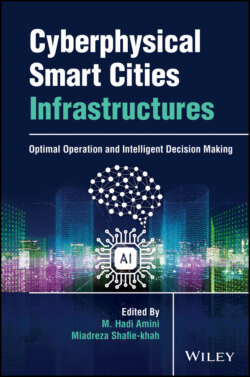Читать книгу Cyberphysical Smart Cities Infrastructures - Группа авторов - Страница 2
Table of Contents
Оглавление1 Cover
2 Title Page
3 Copyright
4 Biography
5 List of Contributors
6 1 Artificial Intelligence and Cybersecurity: Tale of Healthcare Applications 1.1 Introduction 1.2 A Brief History of AI 1.3 AI in Healthcare 1.4 Morality and Ethical Association of AI in Healthcare 1.5 Cybersecurity, AI, and Healthcare 1.6 Future of AI and Healthcare 1.7 Conclusion References
7 2 Data Analytics for Smart Cities: Challenges and Promises 2.1 Introduction 2.2 Role of Machine Learning in Smart Cities 2.3 Smart Cities Data Analytics Framework 2.4 Conclusion References
8 3 Embodied AI‐Driven Operation of Smart Cities: A Concise Review 3.1 Introduction 3.2 Rise of the Embodied AI 3.3 Breakdown of Embodied AI 3.4 Simulators 3.5 Future of Embodied AI 3.6 Conclusion References
9 4 Analysis of Different Regression Techniques for Battery Capacity Prediction 4.1 Introduction 4.2 Data Preparation 4.3 Experiment Design and Machine Learning Algorithms 4.4 Result and Analysis 4.5 Threats to Validity 4.6 Conclusions References Note
10 5 Smart Charging and Operation of Electric Fleet Vehicles in a Smart City 5.1 Smart Charging in Transportation 5.2 Cyber‐Physical Aspects of EV Networks 5.3 Charging of Electric Fleet Vehicles in Smart Cities 5.4 Data and Cyber Security of EV Networks 5.5 EV Smart Charging Strategies 5.6 Conclusion Acknowledgments References Note
11 6 Risk‐Aware Cyber‐Physical Control for Resilient Smart Cities 6.1 Introduction 6.2 System Model 6.3 Risk‐Aware Quality of Service Routing Using SDN 6.4 Risk‐Aware Adaptive Control 6.5 Simulation Environment and Numerical Analysis 6.6 Conclusions References Notes
12 7 Wind Speed Prediction Using a Robust Possibilistic C‐Regression Model Method: A Case Study of Tunisia 7.1 Introduction 7.2 Data Collection and Method 7.3 Experiment and Discussion 7.4 Conclusion References
13 8 Intelligent Traffic: Formulating an Applied Research Methodology for Computer Vision and Vehicle Detection 8.1 Introduction 8.2 Literature Review 8.3 Research Methodology 8.4 Conclusion References
14 9 Implementation and Evaluation of Computer Vision Prototype for Vehicle Detection 9.1 Prototype Setup 9.2 Testing 9.3 Iteration 2: Transfer Learning Model 9.4 Iteration 3: Increased Sample Size and Change of Accuracy Analysis (Images) 9.5 Findings and Discussion 9.6 Conclusion References
15 10 A Review on Applications of the Standard Series IEC 61850 in Smart Grid Applications 10.1 Introduction 10.2 Overview of IEC 61850 Standards 10.3 IEC 61850 Protocols and Substandards 10.4 IEC 61850 Features 10.5 Relevant Application 10.6 Advantages of IEC 61850 (Requirements of Smart Grid IEC 61850) 10.7 Conclusion and Perspective Acknowledgments References
16 11 Electric Vehicles in Smart Cities 11.1 Introduction 11.2 Autonomous Vehicle 11.3 IoT Technology and CAEV 11.4 CAEV Applications and Services 11.5 Cybersecurity Issues of Internet of EVs 11.6 IoT‐Based EV State Estimation and Control Under Cyberattacks 11.7 Effect of EV Charging Behavior on Power System 11.8 Charging Scheme for EVs Using IoT References
17 Author Index
18 End User License Agreement
